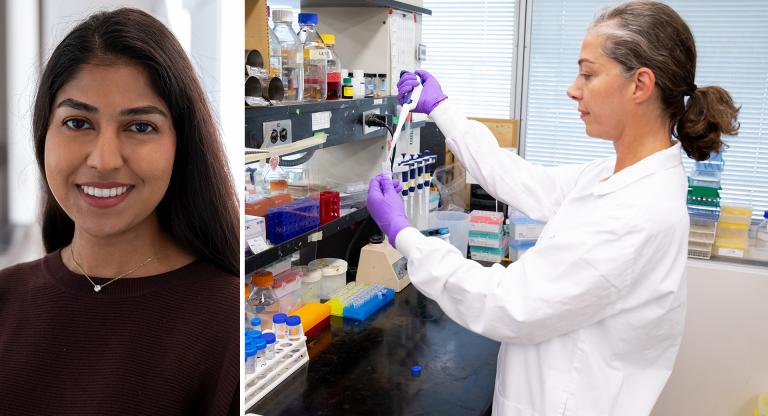Study shows brain-specific protein variants often switch preference for interacting partners

A team of researchers at Sinai Health and the University of Toronto has made significant strides in understanding how subtle changes in brain-specific proteins alter their ability to interact with their partners.
The research dives into the impact of alternative splicing, a cellular mechanism that diversifies proteins by allowing a gene to encode multiple protein variants, akin to using different Lego blocks to build a variety of structures.
The researchers sought to establish how often brain-specific protein variants have different interacting partners, which could improve understanding of brain development and related disorders. The answer turned out to be — most of the time.
“Our study shows there is widespread rewiring of protein interactions by splicing events and this is something we need to pay more attention to,” said Anne-Claude Gingras, Director of the Lunenfeld-Tanenbaum Research Institute, part of Sinai Health, and Vice-President of Research at Sinai Health.
Gingras, globally known for her research on protein interactions, worked on the study with Benjamin Blencowe, Professor of molecular genetics at the Donnelly Centre for Cellular and Biomolecular Research in U of T’s Temerty Faculty of Medicine.
Blencowe is a global leader in the field of alternative splicing, and together the team carried out a systematic analysis of how brain protein networks are affected by splice variants. The journal Molecular Cell published their findings(opens in a new tab).
Alternative splicing allows about 20,000 human genes to create hundreds of thousands of protein variants. This diversity is thought to be critical for cellular functions, especially in the brain, where most splicing events happen. Missteps in this process can lead to brain disorders such as autism and Alzheimer’s disease, as research by Blencowe and others has shown.
During splicing, cells may include or skip parts of a gene’s code, called exons, creating different protein templates. A single variably spliced exon results in two distinct proteins, one with and one without the additional exon-encoded segment. Yet the functional impact of this molecular diversity remains largely unknown.
“We have this massive repertoire of splice variants in the brain and the big question is what they are all doing,” said Gingras, who is also professor of molecular genetics at U of T and holds the Canada Research Chair in Functional Proteomics.
To find out, the team applied affinity-purification mass-spectrometry (AP-MS), a method for measuring protein interactions, to pairs of brain-specific splice variants differing by a single exon. AP-MS a two-step process where a variant of interest and is pulled out of the cell mixture along with all its interacting partners, which are then identified by a mass-spectrometry instrument.
The team used state-of-the-art instruments and expertise in the proteomics research facility at the LTRI’s Network Biology Collaborative Centre(opens in a new tab), co-directed by Gingras.
Jonathan Roth, a graduate student jointly supervised by Gingras and Blencowe, spearheaded the study with Ulrich Braunschweig, a research associate in the Blencowe lab who performed data analysis for the project.
As this was a proof-of-concept study, they focused on a relatively small set of 17 pairs of variants that are important for gene regulation and chromatin remodelling. They then measured and compared the interaction networks between the pairs of variants and looked for any changes.
The majority of the examined protein variants — 60 percent of them — gained or lost at least one interaction partner. The finding indicates that splicing often produces functionally distinct proteins, the researchers said.
“This is more than what we observed previously with older methods, and we think it’s just the tip of the iceberg, said Blencowe, who holds the Canada Research Chair in RNA Biology and Genomics, and the University of Toronto Banbury Chair in Medical Research.
“AP-MS is a more sensitive and unbiased method and it goes to show that you have to apply state-of-the-art technology to really learn the full picture,” he said.
The researchers said it is possible that the remaining variants also have differential interactions under certain conditions — cellular stress, for example — that were beyond the focus of the study.
For two pairs of variants, Roth delved deeper to demonstrate how a single exon can modify a protein’s role. He found, for example, that exon inclusion affected the ability of a protein known as Sap30bp to exert its multitasking functions in the processes of splicing and RNA transport — a novel finding that opened new research directions, said Blencowe.
In an ongoing collaboration between the two groups, Gingras and Blencowe plan to apply the latest mass-spectrometry platforms to expand their study to a much larger set of variants. The goal is a more comprehensive understanding of how splicing affects brain development and function.
“There is an extensive disruption of splicing in diseases and disorders and by understanding these mechanisms, it gives us a new angle for thinking about treatments,” said Gingras.
The research was funded by grants from the Canadian Institutes of Health Research.











